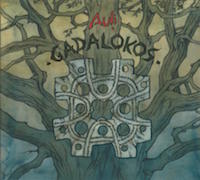Drum and bagpipe folklore group Auļi, who have been playing and performing around the world for more than a decade, have released their latest album Gadalokos. As the title would indicate, the theme of this collection is the Latvian seasons, and includes sixteen compositions (plus two additional bonus reworked songs) that traces the Latvian year, from the frost of winter, all through the spring and summer, and back again to the winter solstice in December.
Auļi, whose distinct sound makes their songs and performances instantly recognizable, have long been one of the best known Latvian folklore acts worldwide. Group members include bagpipe players Kaspars Bārbals, Leanne Barbo, Gatis Indrēvics, Māris Jēkabsons, Edgars Kārklis, and Normunds Vaivads, as well as drummers Kaspars Indrēvics, Edgars Krūmiņš, Mārtiņš Miļevskis, and Andris Buls.
The collection begins with ‘Sala laiks’ (or ‘time of frost’), and the cold beginning of the year still contains a burst of energy (as many of the group’s compositions do). Though it may be dark and cold, the work joyfully heralds the beginning of a new year.
A solemn stabule (or reed pipe) begins the song ‘Ūsiņi’, a celebration of the deity Ūsiņš and heralding the beginning of summer. Ūsiņš is often depicted in Latvian folk songs as riding a horse throughout the fields, and the galloping nature of this song is an appropriately mystic and energetic depiction of this Latvian legend.
Balancing the often masculine Latvian deities are the feminine spirits such as Māra (one of the most important Latvian deities, symbolizing Mother Nature in many ways), and her time of the year is the end of the summer and beginning of the autumn. This time was also a celebration of farm animals such as cows, goats, and sheep. The group present their vision of this day in the song ‘Māras diena’, which begins with a celebratory fanfare in the bagpipes, before presenting the bustle of the day as the farmers gave thanks to their animals (and also baked a lot of bread, also a custom of this day).
The sixteen song cycle comes full circle with the closing track ‘Kaladū!’, a celebration of the winter solstice at the end of December. The work, one of the more somber pieces on the album, is almost mournful, perhaps to reflect the limited daylight of this day. Though this may be the longest night, the winter solstice has many traditions associated with it, particularly the dragging of the log to ward away evil spirits. The song captures this ancient tradition, and also the positive aspects and hope of this day – the longest night is now past, and each subsequent day will become longer and longer.
The CD packaging includes a few notes on the group and the concept of the album, but may have benefitted from additional information about these unique Latvian seasons, as many listeners might not be immediately familiar with events like Metens and Ūsiņi and their significance. There is an interesting note that the album was also inspired by a pendant with a calendar found in an archaeological excavation in Tukums in 1999-2000.
Always energetic and rousing, this journey through the Latvian seasons presented on Gadalokos is a particularly engrossing offering from Auļi. Though limited to just drums and bagpipes on most of the tracks, the music is always engaging and never repetitive. The unique characteristics of each of these days and seasons are presented vividly in these compositions, and the album offers a unique musical view of the rich Latvian folklore calendar.
For further information, please visit the Auļi website.
Auļi
Gadalokos
Lauska, LAUSKA CD065, 2016
Track listing:
- Sala laiks
- Metens
- Sērsnu laiks
- Lieldienu kadrija
- Pavasara laiks
- Ūsiņi
- Ziedu laiks
- Jāņu nakts
- Siena laiks
- Māras diena
- Rudens laiks
- Apjumības
- Veļu laiks
- Mārtiņi
- Ledus laiks
- Kaladū
- Salniņa
- Pieguļā




